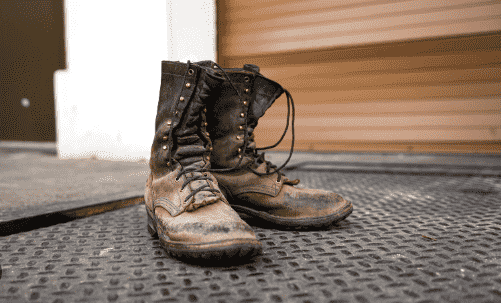how to keep work boots from stinking. Introduction
Importance of Maintaining Work Boots:
Work boots are crucial tools that withstand painful conditions and protect feet from harm. Regular maintenance makes them last longer and keeps them comfortable and clean.
Common Causes of Work Boot Odor:
Odor in work boots commonly stems from sweat, microorganism boom, and moisture buildup. Understanding those elements enables the enforcement of powerful scent-prevention strategies.
Brief Overview of the Guide:
These are reasonable suggestions in the manual and strategies for preventing and eliminating painting boot odour and keeping shoes fresh and snug.

Choose the Right Work Boots
Materials That Reduce Odor:
Different materials have different levels of breathability and smell protection. Leather, for example, lasts a long time but needs special care to keep its smell under control. On the other hand, synthetic materials may be better at removing wetness.
Features for Odor-Resistant Boots:
Look for boots with moisture-wicking linings, antimicrobial treatments, and breathable construction. These capabilities help inhibit bacterial growth and keep toes dry.
Recommendations for Top Brands/Models:
Highlight unique manufacturers and styles that are known for their scent-resistant properties, supplying readers with reliable options to remember for their next pair of work boots.
Regular Cleaning Routine
Daily Cleaning Tips:
I recommend daily practices, including wiping down boots, removing debris, and allowing them to air out. This prevents dirt and sweat from collecting, lowering the smell.
Weekly Deep Cleaning Process:
Outline a step-by-step procedure for deep cleaning boots. This procedure consists of removing insoles, scrubbing with a slight purifier, and thoroughly drying to cast off deep-seated odours.
Effective Cleaning Products for Work Boots:
Suggest cleaners and conditioners suitable for truly unique boot materials, ensuring readers that the products they use correctly clean the boots without causing them to be unfavourable.
Use Odor-Fighting Insoles
Benefits of Odor-Absorbing Insoles:
Explain how specialized insoles absorb moisture and neutralize smells, making people feel better and fresher.

Types of Insoles (Activated Charcoal, Antibacterial, etc.):
Numerous insoles, including activated charcoal for scent absorption and antibacterial options to prevent microbial growth, are detailed.
How to Fit and Replace Insoles Properly:
This section Provides guidance on deciding on the right size insoles, placing them successfully, and knowing when to update them to maintain top-of-the-line scent management.
Maintain Proper Foot Hygiene
Importance of Clean, Dry Feet:
Emphasize the position of foot hygiene in stopping boot scents, which includes washing feet each day, drying very well, and carrying clean socks.
Recommended Foot Care Products (Antibacterial Soaps, Powders, Sprays):
Suggest specific products, such as antibacterial soaps for foot washing, powders to soak up moisture, and sprays to inhibit bacterial growth.
Tips for Preventing Foot Sweat and Odor:
Provide practical advice, such as wearing socks that wick away sweat, changing socks every hour if needed, and applying footpowder before putting on boots.
Allow Boots to Breathe
Importance of Ventilation:
Explain how proper ventilation reduces moisture buildup in internal boots, which is critical for stopping odour.
Best Practices for Airing Out Boots After Use:
Advice on techniques like putting off boots right now after paintings, storing them in a nicely-ventilated place, and using wooden boots or inserts to hold shape and airflow.
Use of Boot Dryers and Other Ventilation Devices:
Discuss the advantages of using boot dryers or placing boots near airflow sources to rush drying and reduce scent-inflicting bacteria.
Use Natural Odor Absorbers
Everyday Household Items That Absorb Odors (Baking Soda, Cedar Chips, and many others.):
List herbal smell absorbers that can be placed on interior boots, including baking soda, to neutralize odours and cedar chips for their natural antimicrobial homes.
DIY Odor Absorber Recipes:
Provide easy DIY recipes for homemade scent readers that offer value-effective alternatives to industrial goods, like dampers.
How to Use and Replace Natural Odor Absorbers in Boots:
This section explains how to use these natural absorbers effectively, including putting on the boots and regularly replacing them to maintain effectiveness.
Rotate Your Footwear
Benefits of Not Wearing the Same Boots Every Day:
Highlight the blessings of alternating between more than one pair of shoes, allowing each pair to air out and lowering wear and tear.
How to Create an Effective Footwear Rotation Schedule:
Provide a pattern schedule for rotating boots, thinking of workdays, climate conditions, and boot fabric sturdiness.
Tips for Storing Extra Pairs of Work Boots:
Offer storage suggestions to keep unused boots smooth and dry, which include using shoe racks or boxes in a cool, dry place far away from direct sunlight.

Preventative Measures
Wearing Moisture-Wicking Socks:
Explain how moisture-wicking socks draw sweat far from the pores and pores and skin, reducing moisture in internal boots and stopping odour.
Using Foot Powders or Sprays Before Wearing Boots:
I advocate applying powders or sprays to the boots before you put them on to remove moisture and create a barrier against bacteria that cause smells.
Tips for Maintaining a Dry Environment for Your Boots:
Provide steerage on storing boots in dry surroundings, keeping off damp regions that sell mould and mildew increase.
Conclusion
Recap of Key Points:
Summarize the principle techniques mentioned throughout the manual for stopping and eliminating work boot odour.
Encouragement to Maintain Boot Hygiene Regularly:
Stress how vital regular maintenance is to keep the boot’s overall performance and luxury.
Final Thoughts and Additional Resources for Further Reading:
Provide remaining comments and support other resources, like blogs or books, where readers can learn more about boot care and hygiene.
